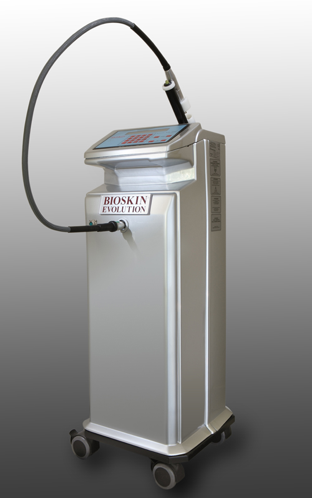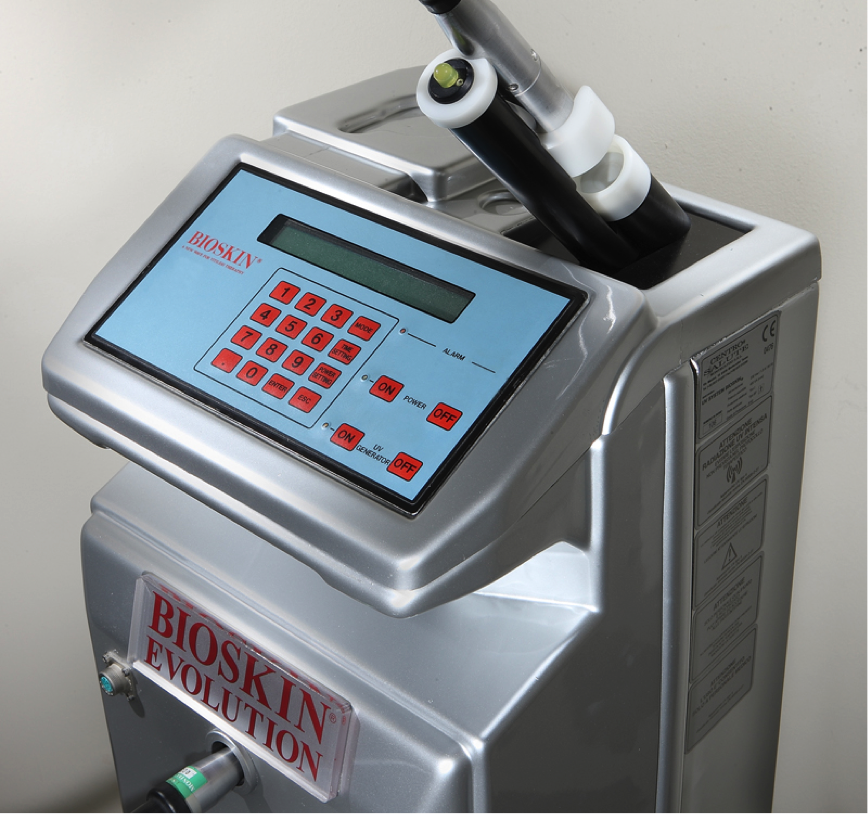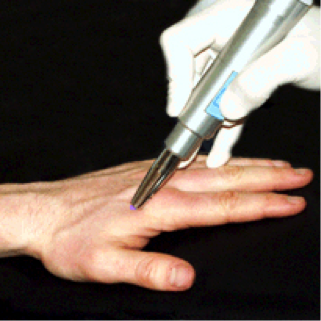There are many treatments that can be used for the problem of vitiligo. One fact that has been determined is that treatment of vitiligo is aided by exposure to sun, even though sunlight often causes erythema; real sunburns should, however, be avoided. The reasons why light rays are important in the treatment of vitiligo are not completely clear, although two of the main effects of sunlight on the skin are undeniably melanocyte pigmentation and local immunosuppression.
According to recent studies, ultraviolet B (UVB) radiation at 311 nm would be much more important in the treatment of vitiligo than ultraviolet irradiation with other wavelengths, mainly because of its particular direct and indirect actions on the cutaneous immune system.
BIOSKIN EVOLUTION® therapy has been developed on the basis of this type of research. This therapy involves innovative equipment that is unparalleled in terms of technology and therapeutic effects.
BIOSKIN EVOLUTION® is based on a technique of microphototherapy capable of conveying a beam of light, of the wavelength that scientific studies have demonstrated to stimulate melanocytes to duplicate and produce melanin most effectively, exclusively onto the patches of vitiligo, without creating the damage caused by other radiation in sunlight, in particular infrared and ultraviolet A (UVA) rays. The other undeniable advantage is the possibility of creating a system of treatment that is personalised according to the spread and sensitivity of the areas affected and based on the response to treatment of each individual.
Cold-light microphototherapy
The phototherapy techniques currently used have the disadvantage of treating the whole surface area of the body, even when the zones affected constitute only a small proportion of the whole skin. Being able to treat exclusively the affected areas has many advantages:
- it reduces the total dose of exposure of the person to ultraviolet B rays in proportion to the area of skin involved, greatly decreasing the risk of developing skin cancers of both melanocytic type and other types;
- it does not increase the difference in colour between the healthy skin and the diseased skin. In fact, with the usual phototherapy techniques, the skin surrounding a white patch becomes increasingly pigmented, thus increasing the visibility of the patches and the disturbance that they cause;
- it allows the intensity and total amount of ultraviolet B radiation to be adapted according to the part of the body being treated. For example, the hands are notorious for needing much more ultraviolet electromagnetic radiation than the eyelids.
The new technique of phototherapy of vitiligo called BIOSKIN EVOLUTION® Microphototherapy is carried out using computerised equipment, capable of stimulating skin affected by vitiligo with well-defined doses of a particular cold light, excluding the areas of skin not affected.
Cold-light Bioskin therapy®
Microphototherapy is performed using the BIOSKIN® system which enables radiation of small, roundish areas (1 cm in diameter) with pulses of ultraviolet B (UVB) light well-defined by the person administering the treatment. The BIOSKIN® system has three fundamental components:
- a UVB generator;
- a very special fibre optic that carries the ultraviolet rays from the generator to the skin to be treated;
- the electrical and mechanical parts that are used to vary both the intensity of the UVB radiation and for how long it is emitted.

The generator supplies radiation comprised for the most part within the spectrum of ultraviolet A and B radiation, with a series of specifically designed and created filters that only allow the passage of radiation with a wavelength peaking at 311 nm.
The fibre optic is actually an optical system made of quartz and fluids that are optically inert with respect to ultraviolet rays and, therefore, allow the passage of these rays. This would be absolutely impossible with an optical fibre made of ordinary glass.
The “electro-mechanical” components regulate the intensity and duration of the beam of light through a flow of current to the generator and the use of a mechanical shutter controlled electronically by the operator.
The features of the BIOSKIN® system enable the intensity of the radiation to be regulated in a range from 0 to 100 mW through a potentiometer. The time that the shutter remains open is, in its turn, set by the operator according to the dose to be delivered, which is established for each area to treat before starting the therapy.

Treatment with BIOSKIN EVOLUTION®
The minimum dose is established through exposure of both healthy skin and affected skin to increasing doses of the cold light. Once the dose with which to treat the affected area has been determined, the light beam is directed at the whole white patch in order to irradiate it uniformly.
The treatment is started at the most sensitive areas (for example, the eyelids) for a period that is gradually increased over time.

The treatment is completed when pigmentation is achieved, which may occur in a variable period from a few months to 2 years. The duration of the treatment depends mainly on the site of the patches (the face and trunk usually become pigmented again much more quickly than other sites) and on the clinical behaviour of the vitiligo at the time the patient starts the therapy (that is, whether the vitiligo is expanding or in a quiescent phase).
Re-pigmentation in vitiligo
The response in terms of re-pigmentation is usually seen within 3-4 months after starting the treatment, with the appearance of melanic spots with a diameter ranging from 0.1 to 5 mm. Usually the tiny spots enlarge and merge together so that the area regains the colour of the healthy surrounding skin.
The clinical results are measured by comparing digital pictures of the patient’s skin at regular intervals of time (usually every 3 -4 months). Obtaining good pictures of a patient with vitiligo is not always easy, because the colour alterations are visible in patients with a dark phototype or during the summer season. Thus, in order to get a precise measurement of the size of the patches, a light system that artificially enhances the contrast between the healthy skin and the skin affected by vitiligo must be used. The best system so far is to illuminate the surface of the skin with Wood’s light: this type of ultraviolet light makes the white patches of vitiligo fluorescent.
Cold-light microphototherapy is particularly indicated in subjects with segmental vitiligo and in patients with bilateral, symmetrical vitiligo that does not affect more than 40% of the body’s surface area.
The advantage of BIOSKIN EVOLUTION® therapy is that is concentrated only on the areas affected by vitiligo and can be repeated every 2-4 weeks rather than requiring treatment sessions three times a week, as needed by other common phototherapies.
Microphototherapy should not be used in some subjects: people with diseases sensitive to light (systemic lupus erythematosus, xeroderma pigmentosum, porphyria, cutaneous viral infections in the acute phase, etc.) and also in subjects undergoing systemic or topical pharmacological treatment with photosensitising drugs or substances that are chemical unstable if exposed to ultraviolet rays.
BIOSKIN EVOLUTION® microphototherapy is not harmful in any other people, is easy to use and is truly effective at inducing re-pigmentation of areas of skin affected by vitiligo.
Recovering from vitiligo
The response in terms of re-pigmentation is usually seen within 3-4 months after starting the treatment, with the appearance of melanic spots with a diameter ranging from 0.1 to 5 mm.
Usually the tiny spots enlarge and merge together so that the area regains the colour of the healthy surrounding skin.
The clinical results are measured by comparing digital pictures of the patient’s skin at regular intervals of time (usually every 3 - 4 months). Obtaining good pictures of a patient with vitiligo is not always easy, because the colour alterations are visible in patients with a dark phototype or during the summer season. Thus, in order to get a precise measurement of the size of the patches, a light system that artificially enhances the contrast between the healthy skin and the skin affected by vitiligo must be used. The best system so far is to illuminate the surface of the skin with Wood’s light: in fact, this type of ultraviolet light makes the white patches of vitiligo fluorescent.
Microphototherapy is particularly indicated in subjects with segmental vitiligo and in patients with bilateral, symmetrical vitiligo that does not affect more than 40% of the body’s surface area.
There are no particular contraindications to this treatment because the dose of ultraviolet irradiation to the skin is less than that delivered with conventional treatments.
The advantage of BIOSKIN® therapy is that is concentrated only on the areas affected by vitiligo and can be repeated every 2-4 weeks rather than requiring treatment sessions three times a week, as needed by other common phototherapies.
Microphototherapy should not be used in some subjects: people with diseases sensitive to light (systemic lupus erythematosus, xeroderma pigmentosum, porphyria, cutaneous viral infections in the acute phase, etc.) and also in subjects undergoing systemic or topical pharmacological treatment with photosensitising drugs or substances that are chemical unstable if exposed to ultraviolet rays.
BIOSKIN® microphototherapy is not harmful in any other people, is easy to use and is truly effective at inducing re-pigmentation of areas of skin affected by vitiligo.

